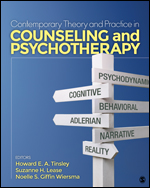Contemporary Theory and Practice in Counseling and Psychotherapy
Howard E. A. Tinsley - Western Washington University, USA
Suzanne H. Lease - University of Memphis, USA
Noelle Susanna Giffin Wiersma - Whitworth University
This comprehensive, topically arranged text provides a contemporary account of counseling theories as practiced by internationally acclaimed experts in the field. Each chapter covers the way mindfulness, strengths-based positive psychology, and the common factors model is integrated into the theory. A special emphasis on evidence-based practice helps readers prepare for their work in the field.
Key Features
- The text focuses on how each theory presents a useful and effective basis for contemporary practice, providing students with the most up-to-date scholarship on current theories and how these theories guide the practice of today’s counselors and psychotherapists.
- Chapters are written by internationally acclaimed experts offering a truly global and complete perspective of the field.
- Discussion of the pros and cons of each theoretical approach allows students to explore all sides of an approach, offering an opportunity for balanced, critical analysis of the material.
- Brief therapies or “manualized” approaches, developed in response to the limits imposed by insurance companies on the number of reimbursable therapy sessions per client, are addressed, as many theoretical approaches offer strategies for providing these therapies.
- Careful discussion in every chapter of the applicability of theories to a diverse client population allows readers to address the specific needs of a broader clientele while acknowledging gender, race, age, sexual orientation, religion, etc.
- Integrated coverage of and a separate chapter on evidence-based practice introduce students to what is becoming the expected standard for effectively working with clients.
- Lists of additional resources from expert contributors allow students to further explore the concepts presented.
Available formats
See what’s new to this edition by selecting the Features tab on this page. Should you need additional information or have questions regarding the HEOA information provided for this title, including what is new to this edition, please email sageheoa@sagepub.com. Please include your name, contact information, and the name of the title for which you would like more information. For information on the HEOA, please go to http://ed.gov/policy/highered/leg/hea08/index.html.
For assistance with your order: Please email us at textsales@sagepub.com or connect with your SAGE representative.
SAGE
2455 Teller Road
Thousand Oaks, CA 91320
www.sagepub.com
Password-protected Instructor Resources include the following:
- A Microsoft® Word® test bank is available containing multiple choice, true/false, short answer, and essay questions for each chapter. The test bank provides you with a diverse range of pre-written options as well as the opportunity for editing any question and/or inserting your own personalized questions to effectively assess students’ progress and understanding.
- A Respondus electronic test bank is available and can be used on PCs. The test bank contains multiple choice, true/false, short answer, and essay questions for each chapter and provides you with a diverse range of pre-written options as well as the opportunity for editing any question and/or inserting your own personalized questions to effectively assess students’ progress and understanding. Respondus is also compatible with many popular learning management systems so you can easily get your test questions into your online course.
- Editable, chapter-specific Microsoft® PowerPoint® slides offer you complete flexibility in easily creating a multimedia presentation for your course.
- Chapter summaries from the book emphasize key concepts on a chapter-by-chapter basis to help with preparation for lectures and class discussions.
- Additional resources from the book are included by chapter.
- An Instructor’s Manual collates resources chapter-by-chapter for use in teaching your course.
The open-access Student Study Site includes the following:
- A scales and exercises page provides access to the scales, exercises and assessments from the book, which can be downloaded and edited in Microsoft® Word®.
- Each chapter includes web resources covering important topics and designed to supplement key points within the text.
- EXCLUSIVE! Access to certain full-text SAGE journal articles have been carefully selected for each chapter. Each article supports and expands on the concepts presented in the chapter. This feature also provides questions to focus and guide your interpretation.
- Additional resources from the book are included by chapter-by-chapter.
KEY FEATURES:
- The text focuses on how each theory presents a useful and effective basis for contemporary practice, providing students with the most up-to-date scholarship on current theories and how these theories guide the practice of today’s counselors and psychotherapists.
- Chapters are written by internationally acclaimed experts offering a truly global and complete perspective of the field.
- Discussion of the pros and cons of each theoretical approach allows students to explore all sides of an approach, offering an opportunity for balanced, critical analysis of the material.
- Brief therapies or “manualized” approaches, developed in response to the limits imposed by insurance companies on the number of reimbursable therapy sessions per client, are addressed, as many theoretical approaches offer strategies for providing these therapies.
- Careful discussion in every chapter of the applicability of theories to a diverse client population allows readers to address the specific needs of a broader clientele while acknowledging gender, race, age, sexual orientation, religion, etc.
- Integrated coverage of and a separate chapter on evidence-based practice introduce students to what is becoming the expected standard for effectively working with clients.
- Lists of additional resources from expert contributors allow students to further explore the concepts presented.

